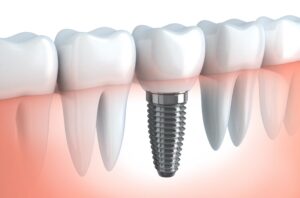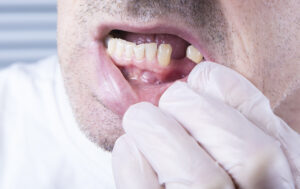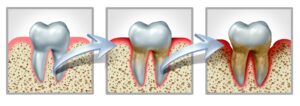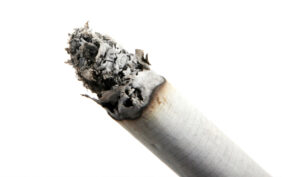Header logo
header top contact widget
Stroke
How the “Bad” Bacteria in the Mouth Can Lead To Serious Health Problems
Posted on Aug 08, 2023 by William J. Claiborne, DDS MS
The human body is a fascinating structure. It seems every year there are new findings that show just how complex and amazing it is.
 Recently, one of the biggest areas of interest has been the study of microbiome in the body. Once thought to be icky little cesspools, these colonies of microorganisms are now seen as having an important role in our health. For example, the microbiome in the gut has been shown to aid in digestion and it’s now seen that skin microbiome may potentially help people overcome conditions like acne and eczema.
Recently, one of the biggest areas of interest has been the study of microbiome in the body. Once thought to be icky little cesspools, these colonies of microorganisms are now seen as having an important role in our health. For example, the microbiome in the gut has been shown to aid in digestion and it’s now seen that skin microbiome may potentially help people overcome conditions like acne and eczema.
As a periodontist, I’ve followed research in how microbiome is being recognized for having a positive role in oral health. While bacteria that convert sugar to acid are the driving force behind tooth decay, this means that those critters in our mouths are not always bad guys.
There are about 700 different species of bacteria in your mouth. Some can be “bad,” yet the good bacteria are able to give our overall health a “leg up” in certain regards.
Certainly, having a clean, healthy mouth helps to prevent cavities and periodontal (gum) disease. However, read on to learn how the health of your mouth can contribute to your overall health to a rather significant extent.
Over the years, numerous studies have been able to pinpoint how diseases – such as heart disease, diabetes, arthritis, and more – might be triggered. The “trigger” seems to consistently link back to internal inflammation.
Inflammation in the body has been shown to set actions into play that cause the onset or worsening of a wide variety of health problems. Periodontal (gum) disease is a chronic inflammatory disease. This means the bacteria attacking gum tissues are in a consistently active state.
When the bacteria of gum disease enter the bloodstream (through tears in weakened gum tissues), it can create inflammatory triggers far beyond the mouth. This bloodborne inflammation, in turn, results in higher risks for heart disease, stroke, diabetes, preterm babies, arthritis, respiratory diseases and even impotency.
How can this occur?
In chronic inflammation, the body’s defense mechanism becomes stuck in the ‘on’ position. This sets off a chain of reactions that alter the helpful response of the immune to a harmful one. When an area in the body stays in an inflammatory setting, damaging reactions can occur.
Once in the bloodstream, several species of harmful gum disease bacteria can add to existing inflammation, including that in the arteries, where it can lead to heart attack and stroke.
In one study of 265 stroke patients, researchers found that patients with gum disease had twice as many strokes (due to thickening and hardening of brain arteries) as patients without. Additionally, patients with gum disease were three times as likely to have a stroke involving blood vessels in the back of the brain, which controls vision, coordination and other functions.
In a separate study of over 1,100 patients who had not experienced a stroke, researchers noted that 10% had severely blocked brain arteries. They also found that patients with gum inflammation were twice as likely to have moderately severe narrowing of brain arteries.
Another example is in the similarities between tissues of gum disease and those taken from arthritic joints. Studies show that gum disease is not only a risk factor for arthritis (both are inflammatory diseases), one can contribute to the other. Thus, gum disease is a risk factor for developing RA and arthritic patients have a greater risk for gum disease.
Additionally, people with diabetes are more likely to have periodontal disease than people without it, likely because they’re more susceptible to contracting infections overall, according to the American Academy of Periodontology.
Studies also show that pregnant women with periodontal disease have a greater risk of having pre-term and low birth weight babies. These indications have been found in amniotic fluid and in fetal cord blood samples of infants.
Findings show, too, that the bacteria of periodontal disease may contribute to a higher risk of pancreatic cancer. For years, researchers at the National Cancer Institute and the American Cancer Society have conducted cancer prevention and screening studies.
By studying oral samples, notably higher levels of two types of oral bacteria were measured in study participants with pancreatic cancer. One oral bacteria was found to create a 50% increased risk for pancreatic cancer and the second oral bacteria led to a 59% greater likelihood.
Chronic inflammation, in any area of the body, is a health risk that poses severe health challenges now highly recognized in the medical field. Not surprisingly, we occasionally see patients who have been advised by their surgeons to have their gum health checked prior to surgery. This proactive measure is to reduce risk factors that could complicate surgical outcome.
Your body’s natural defenses along with good oral hygiene — such as daily brushing and flossing — helps to keep bacteria under control. Also, people should readily recognize the signs and symptoms of periodontal disease.
Healthy gums fit snugly around the base of teeth and be a light pink color. Although the initial stage of gum disease (gingivitis) may exist without obvious symptoms, common signs of gum disease include:
• Swollen or puffy gums
• Bright red or purplish gums
• Gums that feel tender or bleed easily
• Spitting out blood when brushing or flossing
• Frequent or persistent bad breath
• Pus pockets between some teeth and gums
• Loose teeth or a change in the way teeth fit
• Painful chewing
• Gums that pull away from teeth or are sensitive to heat and/or cold
Maintaining good at-home oral hygiene is easy and takes just minutes a day. Brush twice a day (two minutes each time) and floss daily. Drink plenty of plain water throughout the day and limit sugar. Have dental cleanings every six months and follow your dental hygienist’s recommendations to keep oral bacteria at minimal levels between visits.
If you suspect you have gum disease or have delayed (or avoided) having regular dental care, call our Asheville periodontal dental office to schedule an examination. Or, ask to begin with a consultation appointment. During this time, we can discuss any concerns and I’ll answer your questions. Call 828-274-9440.
Let’s help you achieve a healthy, confident smile that adds to the well-being of your overall health!
Sources:
https://www.jnj.com/innovation/4-things-scientists-know-about-the-bacteria-in-your-mouth
https://www.nih.gov/news-events/nih-research-matters/identifying-new-contributor-tooth-decay
https://pubmed.ncbi.nlm.nih.gov/26474422/
http://www.health.harvard.edu/press_releases/heart-disease-oral-health
https://www.cancer.org/research/cancer-facts-statistics.html
Grow Older With A Confident Smile That Is An Asset To Your Well-Being
Posted on Jul 27, 2023 by William J. Claiborne, DDS MS
Oliver Wendell Holmes, an associate justice of the U.S. Supreme Court from 1902 – 1932, once said, “Old age is always fifteen years older than I am.”
 For people who’ve reached “a certain age,” it becomes clear that the advantages of aging (such as having more confidence and living life at a slower pace) are mixed with many challenges, mostly regarding health.
For people who’ve reached “a certain age,” it becomes clear that the advantages of aging (such as having more confidence and living life at a slower pace) are mixed with many challenges, mostly regarding health.
From aching joints to loss of muscle strength to poor eyesight and hearing loss, the aging process comes with health challenges that seem to grow in number and severity with each passing year. Sadly, increased risk of tooth loss is also part of the process.
Depending on the retention of wisdom teeth, a full set of adult teeth should be 28 to 32. However, in a five-year study by the National Health & Nutrition Examination Survey, Americans ages 75 and over were missing over 22 natural teeth with over 26% having no remaining teeth (known as being edentulous).
While tooth loss is often perceived as a normal part of the aging process, it is not. Keeping one’s teeth throughout a lifetime is very possible. The health benefits of maintaining natural teeth include, among many others, living a longer life.
Healthy teeth rely on a healthy foundation — your gums. Good oral health has been shown to reduce risks for serious health conditions (including heart disease, stroke, and some cancers) elsewhere in the body. In addition to lowering a number of health risks, keeping your natural teeth is necessary for proper biting, sufficient chewing, digestional health and nutritional intake.
It has also been shown that wearing dentures is a poor method of replacing natural teeth. Even though they recreate the appearance of teeth and restore function (to varying extents), dentures can actually contribute to long-term problems.
Natural tooth roots help to nourish and stimulate the jaw bones that are the supporting structures of teeth. Without them, the bones begin to shrink. Known as “resorption,” this process of bone mass decline can eventually lead to tooth loss. Once resorption begins,, it continues at an ever-increasing cases year after year.
Tooth loss also causes a domino effect of sorts. Statistics show that adjacent teeth beside an area of tooth loss have the highest risk of being the next to be lost.
And the problems associated with dentures continue. The gum-colored base of dentures is porous. This surface provides oral bacteria with tiny hideouts that are breeding grounds for high levels of bacteria. Denture wearers have higher incidences of respiratory problems, including susceptibility to pneumonia. Studies have shown that senior adults who also sleep in their dentures have even higher risks.
Wearing your dentures for prolonged periods of time (such as while you sleep) coupled with the aging process itself can lead to Denture Stomatitis. This condition causes redness, swelling and tenderness in the mouth. While it is most common among denture wearers, it can also occur from a broad spectrum of antibiotics.
Nearly 89% of adults ages 65 and older report they are currently taking any prescription medicine. More than half of adults 65 and older (54%) report taking four or more prescription drugs (compared to 32% of adults 50-64).
While a number of both prescribed and OTC medications include the side effect of oral dryness for any age, age-related reductions in salivary production are more severe for older adults, causing irritation to oral tissues.
Medications including antihistamines, blood pressure medications, decongestants, pain medications, diuretics and antidepressants typically cause dry mouth, which can create inflammation and higher susceptibility to infection.
The aging process causes the condition of “dry mouth.” Saliva plays an important role in maintaining good oral health. A healthy saliva flow makes it easy to talk, swallow, taste, and digest food. A reduction in saliva flow can increase plaque accumulation as well as the risk of developing periodontal disease.
Referred to as gum disease, this bacteria accumulation can lead to tooth decay, mouth sores and oral infections. Inadequate saliva can contribute to bad breath, dry and cracked lips, cause the fit of dentures to become uncomfortable, and result in higher oral infection risk.
An emphasis on maintaining good oral health needs to be front and center for older adults along with their overall health care commitment. Fortunately, good oral health is easy to achieve. Twice-daily brushing, daily flossing and having 6-month dental exams and cleanings can help to minimize problems and address those that do occur at their earliest stages.
It is also important to keep your mouth moist. Drink plenty of water throughout the day. Limit foods and beverages that are caffeinated, which are drying to oral tissues. These include coffee, tea, colas and chocolate as well as spicy foods. If you take medications that have drying side effects, use an oral rinse designed to replenish moisture. Also, chew sugarless gum to help promote saliva flow.
Your diet is an important part of a healthy mouth. Evaluate your food intake carefully. Begin by limiting carbs and sugar. While all foods trigger an acid attack in the mouth for nearly 30 minutes after eating, sugar and carbs super-charge the reproduction of oral bacteria.
When teeth are lost, adults encounter a complicated set of issues – and costly challenges that can reach far beyond the mouth. As a Periodontist, I’ve seen how simple measures can save people greatly in treatment time and expense AND prevent problems like gum disease, cavities and tooth loss.
According to Woody Allen, “You can live to be a hundred if you give up all things that make you want to live to be a hundred.” Your smile should be one of your best assets throughout your lifetime, complementing appearance and as an advantage to your overall health. Don’t let the detrimental impact of tooth loss and risks associated with gum disease make you look and feel old.
If you have begun to lose natural teeth, let us help you halt the process! We can also discuss replacing them with dental implants with our specialized skills in the diagnosis and placement of dental implant.
Call 828-274-9440 to schedule a consultation to discuss how you can regain your oral health for a lasting, healthy smile!
Sources:
https://www.nidcr.nih.gov/research/data-statistics/tooth-loss/seniors
https://www.kff.org/health-reform/issue-brief/data-note-prescription-drugs-and-older-adults/
https://my.clevelandclinic.org/health/diseases/21702-denture-stomatitis
3 At-Home Tips To Lower Risk of Tooth Loss, Gum Disease
Posted on Jun 02, 2023 by William J. Claiborne, DDS MS
Gum disease is the nation’s leading cause of adult tooth loss and one of the most prominent diseases in the U.S., with over 47% of adults having some level.
Yet, this disease is far more devastating than many realize. When oral bacteria build to a point beyond the ability of the immune system to manage, inflammation sets in. This inflammation continues to build as the oral bacteria become infectious.
Oral bacteria is the cause of cavities, gum disease, and a long list of health problems as many years of research has shown. Oral bacteria can become bloodborne through tears in diseased gum tissues, allowing it to travel throughout the body. This can trigger inflammatory reactions that have serious consequences far beyond the mouth.
Because the initial symptoms of periodontal (gum) disease are silent, the early stages of the disease can be perplexing since patients don’t feel anything is wrong. However, like most diseases that form in our bodies, we don’t feel or see anything when they first begin. This allows the disease to progress without our knowledge.
Unfortunately, people tend to delay treatment until the symptoms of periodontal disease are obvious and uncomfortable. These include tender and swollen gums that bleed easily when brushing, consistent bad breath, and gums that are red in color rather than a healthy pink. As gum disease progresses, pus pockets form around teeth as bacterial accumulate. Eventually, teeth will loosen and need to be removed.
Although gum disease can begin without any obvious symptoms, once it exists, progression occurs in three stages (without treatment).
• Gingivitis – As the initial stage of gum disease, inflammation is triggered by plaque buildup at the gum line. When daily brushing and flossing fail to thoroughly remove plaque, toxins form that cause irritation to the gum tissues. Once signs emerge, they may include seeing blood in the sink when brushing or having sore, swollen gums. At this stage, however, damage may be reversed with prompt response.
• Periodontitis (gum disease) – As the disease progresses, the bone structures and fibers that support teeth are damaged by the destruction of infectious oral bacteria. At this stage, inflamed gums form pockets below the gum line, filling with bacteria-laden plaque.
• Advanced Periodontitis – In the advanced stage of gum disease, fibers and bone supporting natural teeth are destroyed. This can cause teeth to shift or loosen, requiring aggressive treatment to prevent tooth loss. Eventually, some teeth may require removal.
As devastating as tooth loss can be to one’s overall health, the bacteria of gum disease can enter the bloodstream. Research has shown this infectious bacteria can trigger inflammatory reactions elsewhere in the body, correlating to heart disease, stroke, high blood pressure, some cancers, diabetes, arthritis, impotency, preterm babies and more.
Obviously, it is important that people are diligent in the care of their oral health. Yet, statistics in America along these lines are not impressive. The Center for Disease Control’s Division of Oral Health cites that 1 out of every 2 American adults 30 and over has periodontal disease. They also shared that periodontal disease is higher in men than women (56.4% vs. 38.4%) with high prevalence rates among smokers (64.2%) and adults 65+ (70.1%).
As a proponent of dental implants to replace lost teeth, I must acknowledge that there is no perfect replacement for natural teeth. Natural teeth provide a stable, dependable means to chew and enjoy food while their tooth roots keep the jaw bones that support them nurtured and stimulated.
In addition to restoring chewing strength and stability, the dental field is a proponent of dental implants largely because of their ability to halt bone loss. Referred to as ‘resorption,’ this is the shrinking of bone mass, which occurs when tooth roots are no longer present in the jaw bone.
Once resorption begins, it continues at an ever-increasing rate with each year. For those who wear a denture or partial, the pressure an appliance places on the bone ridge accelerates it further. Sleeping in an appliance puts pressure on the ridge 24/7, speeding up the rate of bone loss even more.
Resorption can even be seen; it ages one’s appearance far beyond their actual years. As the jaw bone thins, deep wrinkles form around the mouth. Over time, the mouth appears to have sunk into the face. Jowls form and the chin becomes more pointed (creating a ‘granny look’).
Throughout all this, a denture or partial easily slips, requiring more frequent applications of adhesives or pastes. Relines may help for a time, but each reline will only help for a temporary time as the bone continues to decline in height.
Because dental implants are positioned in the jaw bone, they recreate stimulation, which helps them maintain healthy bone mass. They provide dependable, comfortable chewing and speaking ability. And, best of all, they’re designed to last a lifetime.
However, the goal is to avoid the devastation of gum disease. And, this begins at home. While your involvement with your general dentist is very important (with check-ups and cleanings every six months), daily care is a necessary part of having a healthy mouth, lowering disease risks, and keeping your natural teeth (or halting the pace of further tooth loss).
How can you improve your at-home care? There are several ways you can up your game with a few simple add-on’s…
Findings of an 11 year study published in the Journal of Clinical Periodontology tracked the oral health of over 2800 adults. Their use of ELECTRIC TOOTHBRUSHES was monitored to watch for periodontal disease, cavities, and the number of natural teeth.
Participants were examined in 2002 – 2006, with 18% being electric toothbrush users. Follow ups were conducted after 6 and 11 years. At the time of their 11 year follow up, 37 had converted to using electric toothbrushes.
The study showed electric brushing promoted better gum health and slower progression of gum disease. Electric tooth brushing also related to a reduction in tooth loss by 20% (compared to those who brush with manual toothbrushes).
Although manual tooth brushing can be just as effective, it must be done in a proper manner. For manual brushers, some manual brushes can actually be destructive used incorrectly.
For instance, a hard bristle tooth brush can wear down tooth enamel and gum tissues. Too, some people feel the need to press down firmly when brushing and tend to use a scrubbing, ‘back & forth’ motion. This action can wear down the protective shell of tooth enamel, leaving teeth more vulnerable to decay.
To avoid damaging tender gum tissues, choose a soft bristle toothbrush. As you apply gentle pressure on the brush, use a swirling motion. By using a circular pattern over both sides of each tooth and along the tops, teeth are cleansed without wearing away gum tissues. Hint: If the bristles on your toothbrush are fanned out after a couple of months, it’s because you are applying too much pressure when brushing.
Whether using a manual or electric tooth brush, it is necessary to brush twice a day for effective results. In order to thoroughly remove the sticky film of plaque from teeth, you should also brush at least two minutes each time.
Another way to improve gum health, lower cavity risk, and prevent tooth loss is through FLOSSING. It is estimated that only 31% of American adults floss on a daily basis. Because brushing cannot dislodge all food particles caught between teeth, daily flossing should be a part of oral hygiene routines.
Proper flossing is easy for those who are in the habit of it and takes less than a minute. However, the key word here is “proper.” Flossing is best done with about 18 inches of floss. We recommend unwaxed but people with tight teeth find waxed helps them avoid having to ‘pop’ in-between teeth, which can cut into tender gum tissues. Wrap both ends of the floss around the forefingers. Use the thumbs and middle fingers to help maneuver the floss.
Go slowly as you move the floss back and forth to get in-between and scrape down each tooth’s side several times. Move the floss just slightly below the line where teeth meet gum tissues to dislodge bacteria at the base of teeth. Adjust the floss so you have a clean section after flossing every 3-4 teeth. Be sure to scrape the backs of molars (or the farthest back teeth) on top and bottom.
For those who have problems with manual dexterity or find the maneuver awkward, WATER FLOSSERS are effective alternatives (shown to be just as effective as manual flossing) and easy to use. A water flosser pulsates a stream of water between teeth that is forceful enough to dislodge trapped food bits but without harming teeth or gums. They are affordable, available online or in many stores, and easy to use.
Finally, I’ll add the need to keep the mouth moist. A frequent state of ORAL DRYNESS can cause bad breath and lead to higher risks of cavities and gum disease. Saliva, the mouth’s natural rinsing agent, helps to cleanse oral bacteria from the mouth. This keeps bacteria to a minimum and their ability to cause problems at lower risk.
When saliva flow is insufficient, however, bacteria are able to accumulate and multiply rapidly. Contributors to having a dry mouth can occur from consuming alcoholic beverages, caffeine, many medications (both OTC and Rx) and is a normal part of the aging process. Some medical conditions, including acid reflux, sinus infections, diabetes and bronchitis can also cause dry mouth. A bad cold, snoring or just being in the habit of breathing through the mouth are drying as well. Smoking is a major cause of dry mouth.
To overcome the risks imposed by a dry mouth, drink lots of water throughout the day (sports drinks and colas don’t count). Use an ORAL RINSE that is formulated to replenish moisture in the mouth. There are several available over-the-counter (look for ones that DO NOT contain alcohol, which is very drying to oral tissues).
As an Asheville periodontist, I specialize in the treatment of all stages of gum disease, the re-contouring of gum tissues, and the diagnosis and placement of dental implants. Our periodontal dental office optimizes patient outcomes and comfort through our vast array of advanced technology and a commitment to exceptional care. Call (828) 274-9440 to schedule an examination or ask to begin with a consultation.
If dental fear has prevented you from achieving the healthy, confident smile you desire, ask about Oral and I.V. sedation (“twilight sleep”). These are safely administered and recovery is generally quick.
3 Things You’re Doing To Up Your Risk for Gum Disease
Posted on May 15, 2023 by William J. Claiborne, DDS MS
In life, we don’t know what we don’t know. As a periodontal specialist in Western NC, I see this a lot with adults who develop periodontal (gum) disease. Many go most of their lives unaware that certain things they’ve been doing all their lives led (or can lead) to the development of gum disease and often, tooth loss as a result.
According to a report on the health of Americans (published by the CDC, the Centers for Disease Control & Prevention), it is estimated that over 47% have some form of gum disease. Although we all aspire to have a smile that is appealing, it is what lies beneath the teeth and gums that can wreak havoc on one’s overall health.
Over time, inadequate daily oral hygiene enables an overload of bacteria in the mouth. Oral bacteria are living, eating, and reproducing organisms, thriving on rotting food particles caught between teeth. They attack gum tissues and tooth enamel and eventually work down tooth roots and attack the bones and tendons that support teeth.
Early signs of gum disease are frequent bad breath along with swollen, tender and beefy red gums that bleed when you brush. As they grow in number, the gum tissues become weaker and they can penetrate the bloodstream.
Through tears in diseased gum tissues, this infectious bacteria can enter the bloodstream. This potent bacteria are now associated with a number of serious health conditions due to their ability to trigger systemic inflammation. These include heart disease, stroke, some cancers, Alzheimer’s disease and more.
According to the American Academy of Periodontology (www.perio.org),
“Several studies have shown that periodontal disease is associated with heart disease. While a cause-and-effect relationship has not yet been proven, research has indicated that periodontal disease increases the risk of heart disease.
“Scientists believe that inflammation caused by periodontal disease may be responsible for the association.
“Periodontal disease can also exacerbate existing heart conditions. Patients at risk for infective endocarditis may require antibiotics prior to dental procedures. Your periodontist and cardiologist will be able to determine if your heart condition requires use of antibiotics prior to dental procedures.”
Obviously, the goal is to prevent the onset of gum disease. This can be done easily with the investment of just minutes per day and regular dental check-ups and cleanings. The following can give you a good idea as to what you may be doing to make you vulnerable and how to lessen your risks.
• FREQUENT SNACKING
Snacking has become pretty common over the years. Many Americans snack, with such things as a mid-morning latte or afternoon candy bar topped off by a bowl of ice-cream after dinner. All these add-in’s to three meals a day lead up to a bombardment of oral acids in the mouth.
Anytime you eat or drink, an acid attack begins in the mouth. This is a normal part of the digestive system, starting the break-down of foods during the chewing process. However, this also means that every sip of cola or bite of granola bar, an acidic bombardment occurs in the mouth for about 20-30 minutes. When the mouth endures frequent acid attacks during the day, damage to precious tooth enamel will lead to cavities.
Although Americans are the leading nation for sugar consumption, carbs also break down as sugar in the mouth. This means that the potato chips and popcorn you munch on are adding to these risks as well.
• ORAL DRYNESS
Xerostomia, commonly known as “dry mouth,” is a frequent state of oral dryness. Saliva is your mouth’s natural rinsing agent that helps cleanse oral bacteria from the mouth. This keeps bacteria to a minimum.
When saliva flow is depleted, bacteria linger in the mouth longer, giving them more time to multiply. As oral bacteria thrive, reproduce and amass, the initial result is plaque. Plaque is the sticky film you can feel on teeth.
Periodic dry mouth can occur from consuming alcoholic beverages, coffee and certain medications. Although sugary drinks don’t necessarily dry oral tissues (unless they contain caffeine), sugar enhances growth of bacteria reproduction. When food and beverages contain caffeine AND sugar, this hits the mouth with an even higher risk for oral bacteria growth.
Other causes of dry mouth include medications, such as antihistamines and some prescribed for depression and urinary incontinence. Medical conditions, including acid reflux, sinus infections, diabetes and bronchitis are also contributors. A bad cold, snoring or just being in the habit of breathing through the mouth are drying as well. And – the worst culprit of all – is smoking.
• INADEQUATE ORAL HYGIENE AT HOME
Bacteria are living organisms that eat, reproduce and emit waste. Their ability to reproduce is astounding, resulting in a consistently growing number of waste-producing creatures. And they stink, causing bad breath.
Poor oral hygiene is the most common cause for bad breath. Not brushing and flossing or doing so adequately allows oral bacteria to reproduce, which leads to plaque.
When plaque is not removed thoroughly on a daily basis, it turns into a cement-hard substance known as tartar. This mass is actually a solid colony of oral bacteria that attaches to teeth. Once in the form of tartar, it can no longer be brushed or flossed away.
Tartar attacks enamel and gum tissues, causing the gum tissues to become inflamed. This inflammation can quickly develop into gingivitis, an early form of gum disease. If not resolved fully, however, gingivitis can lead to full-blown periodontal disease.
It is estimated that nearly a third of American adults brush their teeth for an insufficient amount of time. Even worse, about that same amount fail to brush twice a day. This means that an alarming amount of bacteria remain to grow and thrive in the mouth.
Proper brushing includes brushing for at least two minutes twice daily with thorough swishing afterwards. Brush using a circular motion rather than scrubbing teeth back and forth (which can damage and wear away tender gum tissues). Never use a hard bristle tooth brush or brush with harsh substances (such as baking soda).
You may be surprised to learn that brushing only tackles about half the amount of oral bacteria. The tongue actually harbors 58 – 65 percent of the bacteria in the “oral cavity.”
Oral bacteria, which take up residence in the tiny bumps and grooves of the tongue, are not easily dislodged. Thus, it is necessary for tongue cleaning to be a part of your oral hygiene regimen at home.
Some toothbrushes have a “tongue scraper” on the reverse side of the bristles that’s an effective option. Or, you can brush your tongue with the bristles after your teeth are brushed. Be sure to reach towards the back of the tongue where the majority of bacteria exist.
If you are experiencing symptoms of gum disease or have not received regular dental care, call 828-274-9440. We’ll arrange a periodontal exam in our comfortable Asheville periodontal office. Or, you can request a consultation appointment to begin. This time will allow you to get to know us and our advanced technology, often saving our patients treatment time while enhancing comfort.
If financial constraints are a concern, ask about our easy payment plans. These can break treatment fees into monthly payments that are manageable to most budgets.
Recent Posts
Categories
Archives
- September 2024
- August 2024
- July 2024
- June 2024
- May 2024
- April 2024
- March 2024
- February 2024
- January 2024
- December 2023
- November 2023
- October 2023
- September 2023
- August 2023
- July 2023
- June 2023
- May 2023
- April 2023
- March 2023
- February 2023
- January 2023
- December 2022
- November 2022
- October 2022
- September 2022
- August 2022
- July 2022
- June 2022
- May 2022
- April 2022
- March 2022
- February 2022
- January 2022
- December 2021
- November 2021
- October 2021
- September 2021
- August 2021
- July 2021
- June 2021
- May 2021
- April 2021
- March 2021
- February 2021
- January 2021
- December 2020
- November 2020
- October 2020
- September 2020
- August 2020
- July 2020
- June 2020
- May 2020
- April 2020
- March 2020
- February 2020
- January 2020
- December 2019
- November 2019
- October 2019
- September 2019
- August 2019
- July 2019
- June 2019
- May 2019
- April 2019
- March 2019
- February 2019
- January 2019
- December 2018
- November 2018
- October 2018
- September 2018
- August 2018
- July 2018
- June 2018
- May 2018
- April 2018
- March 2018
- February 2018
- January 2018
- December 2017
- November 2017
- October 2017
- September 2017
- August 2017
- July 2017
- June 2017
- May 2017
- April 2017
- March 2017
- February 2017
- January 2017
- December 2016
- November 2016
- October 2016
- September 2016
- August 2016
- July 2016
- June 2016
- May 2016
- April 2016
- March 2016
- February 2016
- January 2016
- December 2015
- November 2015
- October 2015
- September 2015
- August 2015
- July 2015
- June 2015
- May 2015
- April 2015
- March 2015
- February 2015
- January 2015
- December 2014
- November 2014
- October 2014
- September 2014
- August 2014
- July 2014
- June 2014
- May 2014
- April 2014
- March 2014
- February 2014
- January 2014
- December 2013
- November 2013
- October 2013
- September 2013
- August 2013
- July 2013
- June 2013
- May 2013
- April 2013
- March 2013
- February 2013
- January 2013
- December 2012
- November 2012
- October 2012
- September 2012
- August 2012
- July 2012
- June 2012


